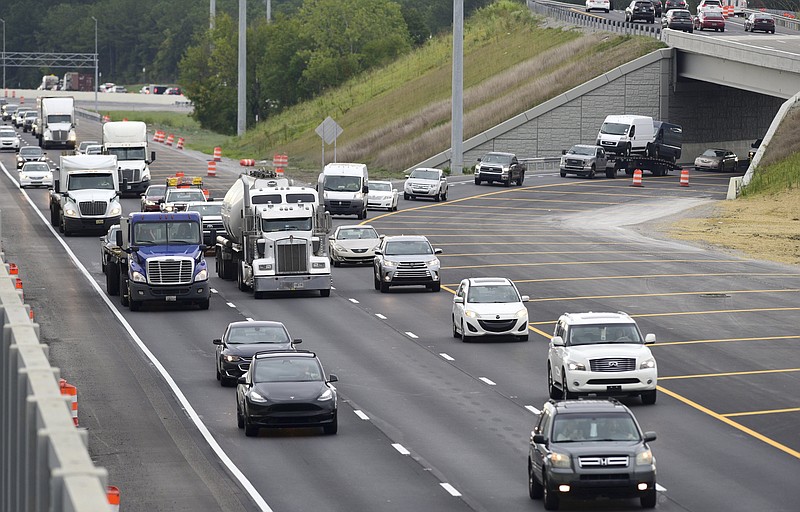The Interstate 75/Interstate 24 Split is still No. 7 on the national Top 20 list of trucking bottlenecks, even after completion of phase 1 of the Tennessee Department of Transportation's $133.5 million reconstruction project to add lanes and ease traffic flow, according to a recent national study of traffic data by a nonprofit group.
The Washington, D.C.-based TRIP, once known as The Road Information Program, issued the report Thursday, placing the Split among the first 10 on the Top 20 list, one of two bottlenecks in Tennessee. In Nashville, the interchange at I-24, Interstate 40 and Interstate 440's eastbound lanes came in at No. 13, while other regional snags high on the Top 20 list include two interchanges on Atlanta's Interstate 285.
The Split's bottleneck ranking is no real surprise for TDOT - and it's fairly obvious to motorists driving through the interchange, where new pavement can be seen that goes nowhere. TDOT acknowledged the lingering bottleneck in August as phase 1 of the Split project came to an end and phase 2 was already in the pipeline.
"We're aware of the congestion issues at this interchange, and we're actively working to fix them, combining everything we accomplished in phase 1 with the proposed improvements scheduled for phase 2," TDOT Region 2 Director Joe Deering said in an emailed statement.
The bottleneck will persist until the second phase is complete, but phase 1 accomplished most of the most inconvenient work, according to TDOT spokesperson Rae-Anne Bradley.
Bradley said Thursday in an email the project was divided in two parts due to funding constraints.
"As you may already be aware, the Tennessee Department of Transportation does not go into debt to fund our projects. We are a pay-as-you-go state," Bradley said. "This project was too expensive to complete under a single contract - which is why it had to be broken up into two separate projects."
Phase 1 addressed the major safety and operational issues with the interchange.
"We were able to complete the bulk of the interchange-specific work in one contract," she said. "It also allowed us to complete the vast majority of construction with minimal impacts to traffic."
Following phase 1, which started in May 2019, traffic flow through the interchange is improved in most directions but the ramp from the northbound lanes of I-75 to the westbound lanes of I-24 near East Ridge's Exit 1 still narrows from two lanes into one, which has been the situation throughout the snarled, six-decade life of the Split. That bottleneck will continue until additional lanes contained in phase 2 of the Split project are completed, according to TDOT.
Phase 2, expected to begin in 2023, will add more lanes and better flow through the Split east toward the "ridge cut" through Missionary Ridge, where I-24 heads toward downtown Chattanooga and points west, according to TDOT.
The TRIP report examines the latest information on the condition and reliability of the nation's supply chain and the critical role of the U.S. freight transportation network in keeping the U.S. economy moving, according to a news release from the nonprofit. The list is based on the analysis of a massive database of truck GPS data and quantifies the impact of traffic congestion on truck-borne freight, according to TRIP officials.
2021’s top trucking bottlenecks
1. Fort Lee, New Jersey: Interstate 95 at State Route 42. Cincinnati, Ohio: Interstate 71 at Interstate 753. Atlanta: Interstate 285 at Interstate 85 north4. Atlanta: Interstate 20 at I-285 west5. Houston, Texas: Interstate 45 at Interstate 69/U.S. Highway 596. Chicago: Interstate 290 at Interstate 90/Interstate 947. Chattanooga: I-75 at Interstate 24Source: American Transportation Research Institute
Pandemic impact
The report finds that, while the number of vehicle miles traveled in the U.S. bottomed out in April 2020 at a level 40% below that in April 2019, that number had rebounded by September of this year to 1.8% below September 2019 levels. Tennessee's vehicle miles traveled was 2.4% below pre-pandemic levels in September 2021.
As travel levels return to pre-pandemic levels, the report's authors said the $1.2 trillion federal infrastructure bill will be critical to states investing in improvements to minimize supply chain disruptions. Tennessee Infrastructure Alliance chair Bill Moore cheers the act's boost to phase 2.
"The recently passed Infrastructure Investment and Jobs Act will provide additional funds to allow [TDOT] to continue with phase 2 improvements to the I-24/I-75 directional interchange in Chattanooga, currently identified in the TRIP report as a freight bottleneck," Moore said in the release.
The act's funding also includes "the continued widening of I-65 to six travel lanes from Nashville to the Kentucky state line, also identified as one of the country's most critical freight corridors," he said.
The infrastructure package passed 228-206, largely along party lines. In Tennessee and Georgia, all Democrats voted for the bill and all Republicans against it.
The first phase of the Split project, launched in spring 2019, consisted of widening existing roads and ramps, increasing the radius of ramps, reconfiguring entrance and exit ramps on I-75, shifting the interchange to the west and modifying the Tennessee Welcome Center area traffic circulation. The project included new bridges for Spring Creek Road over I-24, as well as new interstate bridges throughout the interchange area.
The second phase will extend from the Spring Creek Road overpass to Germantown Road bridge on I-24 and from the bridge over the railroad to the East Brainerd Road exit on I-75, Bradley said.
Smooth move
Until phase 2 is complete, here’s a tip for victims of the bottleneck on I-75 north.After entering the right lanes on I-75 north marked exit only for I-24 west, work to stay in the left exit only lane going toward the overpass to allow room for traffic from East Ridge and the Welcome Center to merge in from the right. The right lane ends soon, so all vehicles must make it to the left “exit only” lane eventually before entering I-24 west.
Phase 2 and you
The work "will include widening I-24 west to allow for three lanes coming from each I-75 ramp - north and south - for a total of six lanes where the ramps meet," she said. "I-24 west will then be tapered back down to three lanes near Germantown Road at the completion of phase 2. This should alleviate remaining traffic congestion now being experienced on the ramps from I-75 to I-24 west."
Widening of the East Brainerd Road interchange is also included in phase 2, along with replacement of the bridges at Moore and McBrien roads over I-24, modification of on- and off-ramps to North Terrace and South Terrace along I-24, the continuation of the widening of I-75 from the bridge over the railroad to the East Brainerd Road exit and the replacement of both bridges, north and south, over the railroad the runs under I-75.
Phase 2 has already been funded for the fiscal year 2022-23 and is expected to be under contract by the end of 2022, meaning drivers should see construction underway on phase 2 in the spring of 2023. Phase 1 was completed on time and within budget, she said.
Donna England, president and CEO of the Tennessee Trucking Association, said the state's ranking will improve as phase 2 construction is completed. She pointed to a finished project in Nashville is an example.
"Our geographic significance continues to be highlighted in the nation's supply chain," England said, noting the Tennessee bottlenecks pinpointed by industry research. "It is important to note TDOT's construction efforts are focused on them. Last year's No. 3 bottleneck is already showing improvement as a result of the completion of the project in Nashville at I-440 and I-24. We would expect to see similar improvements in future studies as construction is progressing on this year's No. 7 bottleneck in Chattanooga at I-24 and I-75, as well."
Contact Ben Benton at bbenton@timesfreepress.com or 423-757-6569. Follow him on Twitter @BenBenton.

